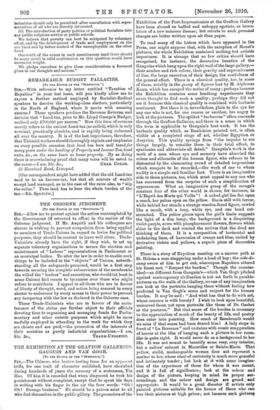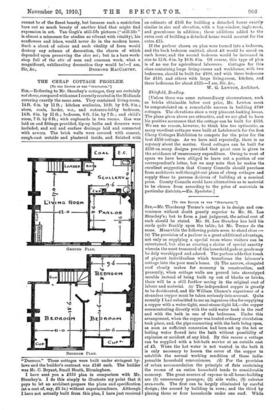THE EXHIBITION AT 1111, GRAFTON GATJYRIES: GAUGUIN AND VAN GOGH.
[To THE EDITOR OF THE "SPECTATOR."]
Szn,—The Chinese, who bestow lasting fame for an apparent trifle, for one trait of character exhibited, have cherished during hundreds of years the memory of a statesman, Yin Hao. Of him it is recorded that when disgraced he took his punishment without complaint except that he spent his days in writing with his finger in the air the four words : " Oh ! Oh! Strange business." He should be a patron saint to all who find themselves in the public pillory. The promoters of the Exhibition of the Post-Impressionists at the Grafton Gallery have been abused as baffled and unhappy egotists, as inocu- lators of a new noisome disease; but retorts to such personal charges are better written upon air than paper.
To read many of the letters which have appeared in the Press, one might suppose that, with the exception of Manet's pictures, the whole Exhibition contained nothing but artistic impostures. It is strange that so few critics should have recognised, for instance, the decorative beauties of the Ganguins which hang upon the right wall of the large gallery,— their sombre and rich colour, their gravity and expressiveness of line, the large execution of fhPir design, the restfulness of the general effect. There is a classical quality, too, in some of them, notably in the group of figures lent by M. Alphonse Kann, which has escaped the notice of many ; perhaps because the Exhibition contains some headlong experiments they never thought to find such a quality; perhaps they did not see it because this classical quality is combined with barbaric sentiment. But there it is, nevertheless, plain to the eye for any one who is not, for one reason or another, too angry to look at the pictures. The epithet "barbarous" often resounds through the Grafton Galleries, and there is a sense in which the term is applicable to Gauguin's best work. It ha.a the barbaric quality which, as Ba.udelaire pointed out, is often visible at a completed stage of art, whether Egyptian Or Assyrian. This quality springs from "the impulse to see things largely, to consider them in their total effect, to synthesise and abbreviate all detail." Gauguin's work is the work of a man whose eye and memory have absorbed the colour and silhouette of the human figure, who refuses to be distracted by the clamouring crowd of detailed impressions which compete to be recorded,—the work of one to whom nudity is a simple and familiar fact. There is an imaginative side to these pictures, too, which must appeal to any one who has recovered from the surprise of such a simplification of appearances. 'What an imaginative grasp of the savage's constant fear of the other world is shown, for instance, in "L'Esprit des Mods qui Veille" l A naked girl lies flat upon a couch, her palms open on the pillow. She is still with terror, while behind her stands a strange wooden-faced figure, cowled like a monk, with a long, white eye, and one hand out- stretched. The yellow gleam upon the girl's limbs suggests the light of a dim lamp; the background is a disquieting violet-purple, sown with phosphorescent flowers, flowers which shine in the dark and remind the natives that the dead are thinking of them. It is a composition of horizontal and undulating lines, of harmonies of orange and blue, united by derivative violets and yellows, a superb piece of decorative painting.
There is a story of Napoleon meeting on a narrow path at St. Helena a man staggering under a load of hay; the aide-de- camp swore at him to get out, whereupon Napoleon uttered his finest mot, "Respect the burden." Though the counter- ideal—so different from Gauguin's—which Van Gogh pitched against contemporary civilisation is not set forth in parable- pictures on the walls of the Gallery, no one of any imagination can look at the portraits hanging there without feeling how profound is Van Gogh's sense and respect for the human burden. It may be said : "And what has that to do with art, whose concern is with beauty ? I wish to look upon beautiful, unmarred faces, not upon portraits like those of Dr. Gachet or the postman." But that sense of the burden is necessary to the appreciation of much of the beauty of life, and poetry does enter into painting. How much of Rembrandt would we miss if that sense had been denied him ! A lady stops in front of "La Berceuse " and exclaims with comic exaggeration of horror at the idea of hanging such a picture in her room. She is quite right. It would never do as a background to her life. It was not meant to beautify some rosy, cosy interior, but a sailors' cabaret in Marseilles or Sainte-Marie. That yellow, stolid, unchangeable woman does not represent a mother to her, whose ideal of maternity is much more graceful and intimately tender ; but look at it with some imagina- tion of the experience of those for whom it was meant, and it is full of significance ; look at the colour and design of the picture, keeping in mind its proper sur- roundings, and the colour and design are grand, and appropriate. It would be a great disaster if artists only painted pictures suitable for the homes of those who can buy their pictures at high prices ; not because such pictures
cannot be of the finest beauty, but because such a restriction bars out so much beauty of another kind that might find expression in art. Van Gogh's still-life pictures (" still-life" is almost a misnomer for studies so vibrant with vitality), his sunflowers and irises, would never do in the modern home. Such a shout of colour and such vitality of form would destroy any scheme of decoration, the charm of which depended upon preserving the dies soi; but in a bare work- shop full of the stir of men and common work, what a magnificent, exhilarating decoration they would be !—I am,



















































 Previous page
Previous page